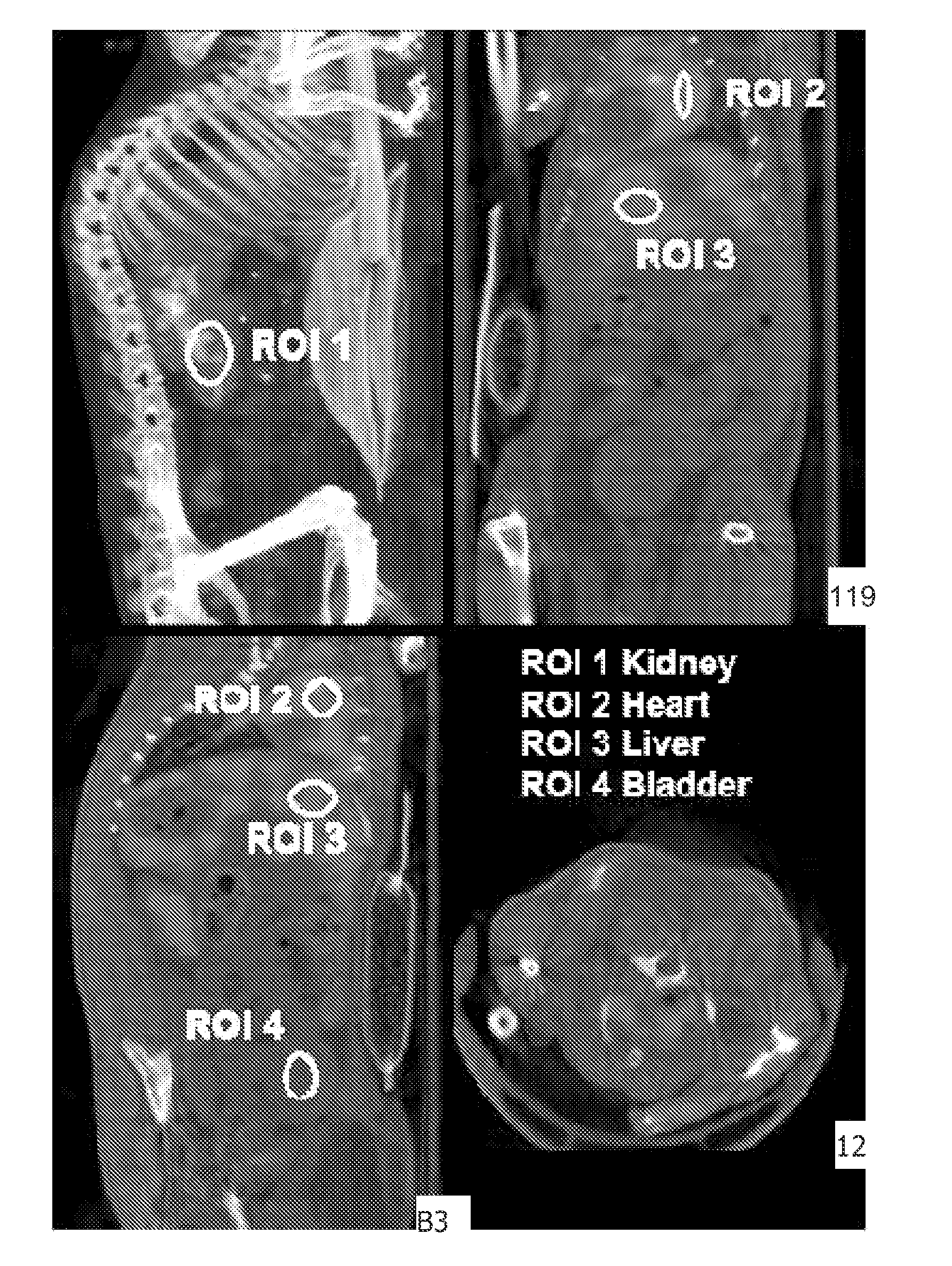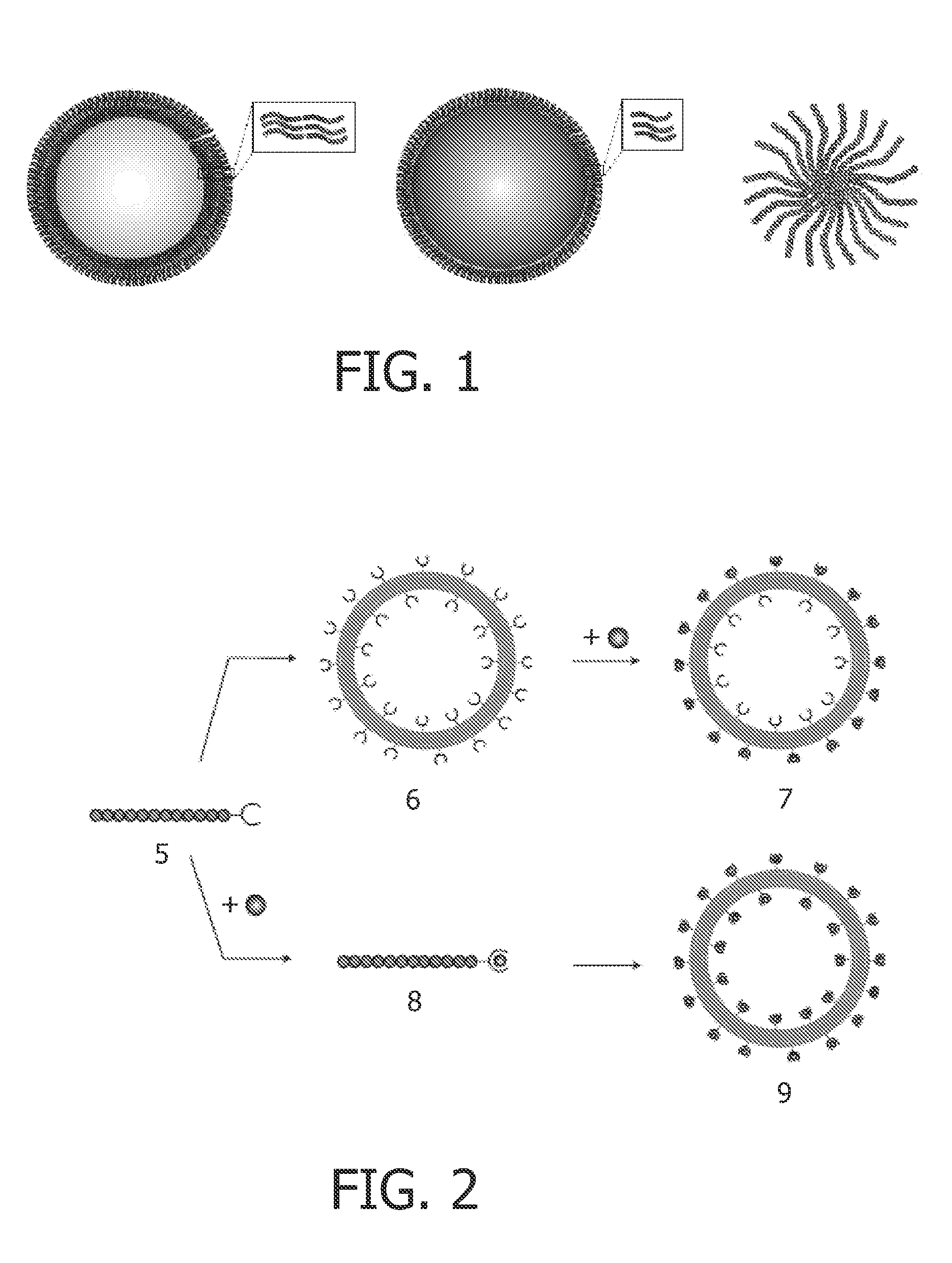Chelating amphiphilic polymers
a polymer and amphiphilic technology, applied in the field of amphiphilic polymers and nanocarriers, can solve the problem of low degree of pegylation
- Summary
- Abstract
- Description
- Claims
- Application Information
AI Technical Summary
Benefits of technology
Problems solved by technology
Method used
Image
Examples
example 1
[0138]Synthesis of DOTA-functionalized poly(ethylene oxide)-block-poly(butadiene) (5)
[0139]PBD(2500)-b-PEO(1300) (1) was dissolved in acetone (18 mL) and the solution was concentrated under reduced pressure in order to remove residual isopropanol. In order to remove traces of water, the copolymer was dissolved in toluene (15 mL) and this solution was concentrated in vacuo. Subsequently, PBD(2500)-b-PEO(1300) (4.90 g, 1.29 mmol) was dissolved in DCM (15 mL) under an atmosphere of nitrogen. The obtained solution was cooled till 0° C. and p-tosylchloride (0.497 g, 2.60 mmol) was added. The mixture was stirred for 30 min at 0° C. and KOH (0.640 g, 11.4 mmol) was added gently. The mixture was stirred overnight at room temperature. The reaction mixture was washed with water (2×30 mL) and brine (2×15 mL). The aqueous layer was extracted with DCM (30 mL) and the combined organic layers were dried over MgSO4, filtered and the solution was concentrated under reduced pressure to yield 2 (62%, ...
example 2
[0140]Self-assembly of DOTA-functionalized copolymers and the complexation with Gd(III).
[0141]Polymer vesicles with an average diameter of 100-150 nm were formed by the thin film hydration technique coupled with sequential extrusions. In brief, the DOTA-functionalized poly(butadiene(1,2-addition)-b-ethylene oxide) (Mn(g / mol): PBD(2500)-b-PEO(1300), PD=1.04, and fEO=0.34) was dissolved in CHCl3. The solvent was gently removed under reduced pressure and a thin polymer film was obtained. The film was hydrated in 20 mM HEPES solution (pH 7.4). After overnight heating at 50° C. followed by ten freeze-thaw cycles at −177° C. and 70° C., the dispersion was extruded several times through polycarbonate filters with a pore diameter of 1 μm, 0.4 μm, 0.2 μm, and 0.1 μm. Subsequently, a solution of GdCl3 (5 equivalents) in 20 mM HEPES solution at pH 7.4 was added to the polymersome dispersion at 50° C. for 2 hours. Subsequently, the polymersomes were dialyzed overnight to remove the excess of Gd...
example 3
[0142]Aspherical polymersomes containing a chemical shift agent and paramagnetic complexes of DOTA-terminated polymers (14)
[0143]Polymer vesicles with an average diameter of 100-150 nm were formed by the thin film hydration technique coupled with sequential extrusions, as described in example 1. In this case the film was hydrated in 20 mM HEPES solution (pH 7.4) containing 65 mM [Tm(hpdo3a)(H2O)]. After overnight heating at 50° C. followed by ten freeze-thaw cycles at—177° C. and 70° C., the dispersion was extruded several times through polycarbonate filters with a pore diameter of 1 μm, 0.4 μm, 0.2 μm, and 0.1 μm. The obtained polymersomes (12) were dialyzed overnight to remove [Tm(hpdo3a)(H2O)] that was not entrapped after hydration of the lipidic film, and to obtain aspherical polymersomes (15). Dialysis was performed with a 20 mM HEPES buffer containing 0.3 M NaCl. Subsequently, a solution of TmCl3 (5 equivalents) in 20 mM HEPES buffer containing 0.3 M NaCl was added to the poly...
PUM
| Property | Measurement | Unit |
|---|---|---|
| Tg | aaaaa | aaaaa |
| amphiphilic | aaaaa | aaaaa |
| hydrophilic | aaaaa | aaaaa |
Abstract
Description
Claims
Application Information
 Login to View More
Login to View More - R&D
- Intellectual Property
- Life Sciences
- Materials
- Tech Scout
- Unparalleled Data Quality
- Higher Quality Content
- 60% Fewer Hallucinations
Browse by: Latest US Patents, China's latest patents, Technical Efficacy Thesaurus, Application Domain, Technology Topic, Popular Technical Reports.
© 2025 PatSnap. All rights reserved.Legal|Privacy policy|Modern Slavery Act Transparency Statement|Sitemap|About US| Contact US: help@patsnap.com



